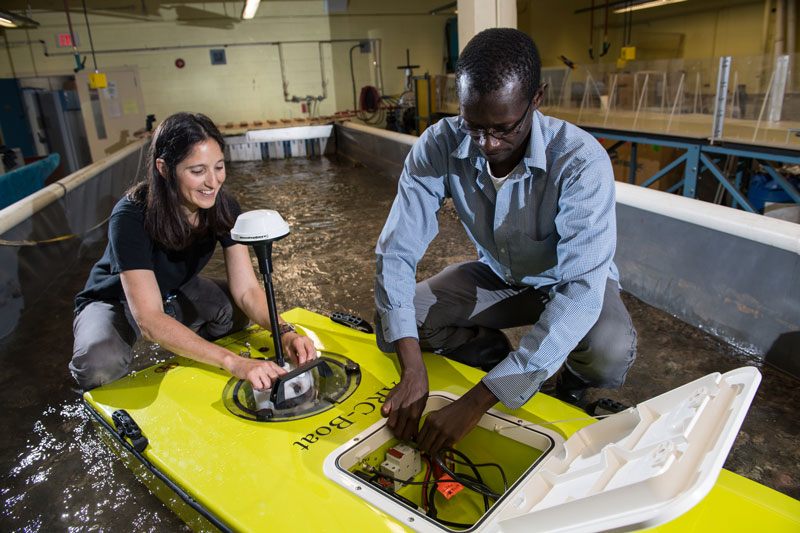The Ecohydraulics of Dam Renewal: Dr. Katy Haralampides Research Has a Direct Impact in New Brunswick
Author: Engineering Alumni Office
Posted on Sep 16, 2017
Category: Research Spotlight
When NB Power realized that the Mactaquac Dam will reach a premature end to its service life by 2030 due to an alkali-aggregate reaction with the concrete (the dam is actually expanding), they called on the Canadian Rivers Institute (CRI) and its UNB/INRS members. The utility needed to decide by 2016 on a preferred option for the future of Mactaquac Generating Station, and so engaged the CRI to design and carry out a large multidisciplinary aquatic ecosystem study to support their decision-making process and subsequent regulatory requirements. NB Power also expressed a desire to prepare local UNB students for future careers working on large-scale development and resource management projects in New Brunswick.

For Dr. Katy A. Haralampides, P.Eng, a Civil Engineering professor and researcher at UNB, it was a chance to work on a project that would have wide-reaching implications not only for New Brunswickers but for researchers and utilities around the world. Whether the preferred option be renewal or removal of the dam, the project would be the largest of its kind ever undertaken in the world – by far. And so the modelling that she and the multidisciplinary team working on the study would be doing would be ground-breaking.
With both a biology and an engineering background, Dr. Haralampides’ research focuses on combining the two in the emerging field of ecohydraulics. She began focusing her studies in the water at the Great Lakes Institute for Environmental Research in Windsor, ON and then moved to the University of New Orleans to research hydrodynamic modelling in nearby Lake Pontchartrain – a large lake-like estuary to the Gulf of Mexico. Since joining UNB in 2000 she’s been working in East Coast waters like the Port of Saint John, the mudflats of the Bay of Fundy, and the Petitcodiac and Restigouche Rivers. She says it’s “so interesting to go from the Great Lakes to the Gulf and now to the Atlantic Ocean and rivers of the East.”
Under the direction of Dr. Allen Curry of the CRI, the Mactaquac Aquatic Ecosystem Study (MAES) is a four-year study initiated in October 2013 to assess the structure and function of the Saint John River ecosystem, followed by the implementation of the preferred option manifesting as a manipulation of flow, sediment load, and thermal regime with consequential effects on the ecosystem. The study outlines the environmental challenges and opportunities for either renewing or removing the station. Dr. Haralampides leads the hydrodynamic modelling and sediment transport components of MAES and their related supporting studies. She says that the study is globally unique because it takes a whole ecosystem approach, and the planned manipulation of an ecosystem of this scale is one of the largest freshwater experiments attempted worldwide. “It’s a real-time experimental playground.”

Dr. Katy Haralampides and her post-doctoral fellow Dr. Mouhamed Ndong working in the Civil Engineering Hydraulics Lab
Using a holistic approach to modelling, the MAES team is studying flow, sediment deposition and movement, temperature, and fish passage and habitat amongst other biological factors. They needed to learn what the bottom of the river looks like, so they collaborated with UNB’s Ocean Mapping Group to develop a high-resolution bathymetry of the headpond and river reaches within the study boundaries, and with UNB’s Geological Engineering who used a variety of geophysics techniques to determine the historical sediment infilling of the headpond. These data allowed Haralampides and her post-doctoral fellow Dr. Mouhamed Ndong to develop numerical models, and then take these findings to NB Power in a highly coordinated effort to regulate flows through the dam in order to obtain more field measurements of flow as needed. They used the Civil Engineering Hydraulics Lab to determine the sheer stress of water on the sediment to improve the accuracy of the sediment transport process. Sediment cores were collected of the historically deposited sediments in the headpond and were processed and sent to the CRI’s Chemistry Lab at UNB Saint John for organic and inorganic chemical analysis to determine if the sediments contained contaminants that could pollute downstream waters and sensitive areas were the dam removed and these sediments transported. All of the resulting data and model ouputs were then applied to an ecological model (CASiMiR) to predict fish habitat changes under the removal option.
In December 2016, NB Power ultimately selected an option to ensure the existing station can operate to its intended 100-year lifespan (2068) using a modified approach to maintenance and replacing critical generation equipment and concrete over time. Now that a “renewal” option has been selected by NB Power, the focus of current modelling is on the near-field around the dam to assist in the design and engineering of fish passage improvements at the existing structure. The team has been asked to gather more data and refine their models to achieve targeted fish passage goals, and there is ongoing work to predict future flows, water levels and temperatures (based on land use and climate change). The modelling output will also be used to develop an environmental flows management scheme with the objective of improving downstream habitats for key native aquatic species.
Haralampides says the project was “massive” and it took a long time to collect data and do the modelling required. “But from Day One the multidisciplinary and collaborative approach, including a very cooperative hydropower company, was tremendous and allowed us to present work that is significant not only here in New Brunswick but also for other similar projects globally.”
For more information on the project, check out the interactive MAES story map.
